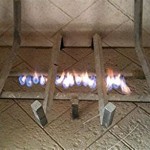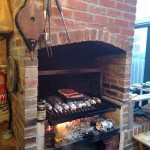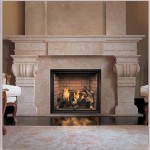Can You Paint A Black Cast Iron Fireplace? A Comprehensive Guide
Cast iron fireplaces, particularly those finished in black, are frequently sought after for their aesthetic appeal and ability to retain heat. However, the finish on a cast iron fireplace may become worn, chipped, or simply outdated over time. In such cases, painting the fireplace is a viable option to refresh its appearance and potentially extend its lifespan. The process requires careful preparation and the selection of appropriate materials to ensure a durable and aesthetically pleasing result. This article will provide a comprehensive guide to painting a black cast iron fireplace, covering essential steps, material choices, and safety precautions.
Preparation is Key: Cleaning and Priming the Fireplace
Before applying any paint, meticulous preparation is paramount. This process ensures proper adhesion of the paint and prevents issues such as peeling or blistering. The first step involves thoroughly cleaning the cast iron surface to remove any dirt, soot, rust, or existing loose paint. A wire brush, sandpaper, and a suitable cleaning solution are essential tools for this task. The specific cleaning solution will depend on the nature of the grime present. For typical soot and dirt, a mixture of water and a mild detergent is often sufficient. More stubborn deposits may require a specialized cleaner designed for cast iron or fireplace surfaces.
The process of cleaning should begin with a coarse wire brush to remove any loose debris and flaking paint. Care should be taken to avoid gouging or scratching the cast iron. Following the initial brushing, sandpaper, typically a medium grit (around 120-150), should be used to further smooth the surface and remove any remaining rust. It is crucial to wear appropriate safety gear, including gloves and a dust mask, to protect against debris and potential irritants. Once the surface is sanded, it should be wiped down with a damp cloth to remove any remaining dust particles.
After cleaning, priming is an essential step to promote paint adhesion and prevent rust. A high-quality, heat-resistant primer specifically designed for metal surfaces is recommended. The primer should be applied in thin, even coats, following the manufacturer's instructions. Allow the primer to dry completely before proceeding to the painting stage. Applying multiple thin coats of primer is preferable to a single thick coat, as this minimizes the risk of drips and ensures a more uniform surface for the paint to adhere to.
If the fireplace has intricate designs or hard-to-reach areas, consider using a spray primer. Spray primers can provide more even coverage in these areas, ensuring that the entire surface is properly prepared. When using a spray primer, ensure adequate ventilation and follow all safety precautions outlined by the manufacturer. Whether using a brush or sprayer, it is important to thoroughly cover all surfaces that will be painted, including any edges or corners.
Selecting the Right Paint: Heat Resistance and Finish
The choice of paint is arguably the most critical factor in achieving a successful and durable finish on a cast iron fireplace. Standard paints are not suitable for this application due to the high temperatures that fireplaces can reach. Using incorrect paint can result in cracking, peeling, discoloration, and the release of harmful fumes. Therefore, it is essential to use a high-temperature paint specifically formulated for use on stoves, fireplaces, and other heat-generating appliances. These paints are typically ceramic-based or contain other heat-resistant additives.
High-temperature paints are available in various finishes, including matte, semi-gloss, and gloss. The choice of finish is largely a matter of personal preference, but it is important to consider the overall aesthetic of the room and the desired look for the fireplace. Matte finishes tend to be more forgiving of imperfections and can create a more traditional or rustic appearance. Semi-gloss and gloss finishes provide a more modern or sleek look and are easier to clean, but they may also highlight any surface imperfections. It is advisable to test the paint on a small, inconspicuous area of the fireplace before applying it to the entire surface to ensure the desired finish and color are achieved.
When selecting a paint, it is also important to consider its durability and resistance to scratching and chipping. Look for paints that are specifically designed for high-traffic areas or those that are formulated to withstand heavy use. Some high-temperature paints also offer rust-inhibiting properties, which can further protect the cast iron from corrosion. Always read the product label carefully and follow the manufacturer's instructions regarding application, drying time, and temperature resistance.
Application methods vary depending on the type of paint chosen. Some high-temperature paints are available in spray cans, while others are designed to be applied with a brush. Spray paints are generally easier to apply and provide a more even finish, but they may require more careful masking and ventilation. Brush-on paints offer more control over the application process and can be more suitable for intricate designs or smaller areas. Regardless of the application method, it is essential to apply the paint in thin, even coats, allowing each coat to dry completely before applying the next. Multiple thin coats are preferable to a single thick coat, as this minimizes the risk of drips, runs, and uneven coverage.
Safety Precautions and Proper Ventilation
Painting a cast iron fireplace involves the use of chemicals and tools that can pose safety hazards if not handled properly. Therefore, it is crucial to take appropriate precautions to protect oneself and the surrounding environment. The first and foremost precaution is to ensure adequate ventilation. Painting should be done in a well-ventilated area, preferably outdoors or with windows and doors open. This helps to prevent the build-up of fumes from the paint and primer, which can be harmful if inhaled. If working indoors, consider using a fan to circulate the air and exhaust fumes to the outside.
In addition to ventilation, it is important to wear appropriate personal protective equipment (PPE). This includes gloves, a dust mask, and eye protection. Gloves protect the skin from contact with chemicals and prevent irritation. A dust mask is essential when sanding or cleaning the fireplace to prevent the inhalation of dust particles and debris. Safety glasses or goggles protect the eyes from splashes and debris. It is also advisable to wear old clothing or a paint suit to protect clothing from paint splatters.
When using spray paints or primers, it is crucial to avoid spraying near open flames or sources of ignition. Many spray paints are flammable and can pose a fire hazard if used improperly. Always read and follow the manufacturer's instructions regarding the safe use and disposal of these products. Store paints and primers in a cool, dry place away from heat and direct sunlight. Keep them out of reach of children and pets.
Proper disposal of used paint cans, brushes, and other materials is also important. Empty paint cans should be disposed of according to local regulations. Some municipalities offer recycling programs for paint cans and other hazardous materials. Used brushes and rollers should be cleaned with appropriate solvents and allowed to dry completely before disposal. Rags or cloths used to wipe up spills or excess paint should be disposed of in a sealed container to prevent spontaneous combustion. By following these safety precautions, it is possible to paint a cast iron fireplace safely and effectively, minimizing the risk of accidents or injuries.
Masking surrounding areas is important to protect them from paint overspray or drips. Use painter's tape and drop cloths to cover any areas that you do not want to paint, such as walls, floors, or furniture. Be sure to use a high-quality painter's tape that will not leave residue on the surface when removed. Press the tape firmly into place to create a tight seal and prevent paint from seeping underneath. Drop cloths should be made of a durable material, such as canvas or plastic, to protect against spills. Overlap the drop cloths to ensure that all surfaces are completely covered.

How To Re A Cast Iron Fireplace Direct Fireplaces

How To Re A Cast Iron Fireplace Direct Fireplaces

How To Re A Cast Iron Fireplace Direct Fireplaces

How To Re A Cast Iron Fireplace Direct Fireplaces

How To Keep Cast Iron Fireplaces Clean

How To Re A Cast Iron Fireplace Direct Fireplaces

How To Re A Cast Iron Fireplace Direct Fireplaces

How To Re A Cast Iron Fireplace
How To Easily Re A Lackre Cast Iron Fireplace Melanie Lissack Interiors

The Beauty Of Cast Iron Fireplace Period Property








